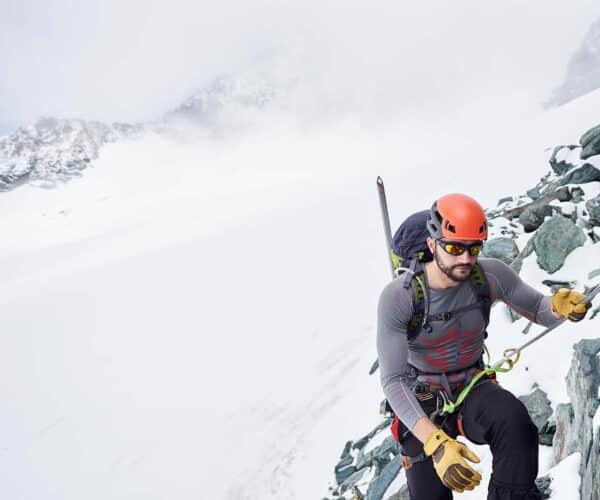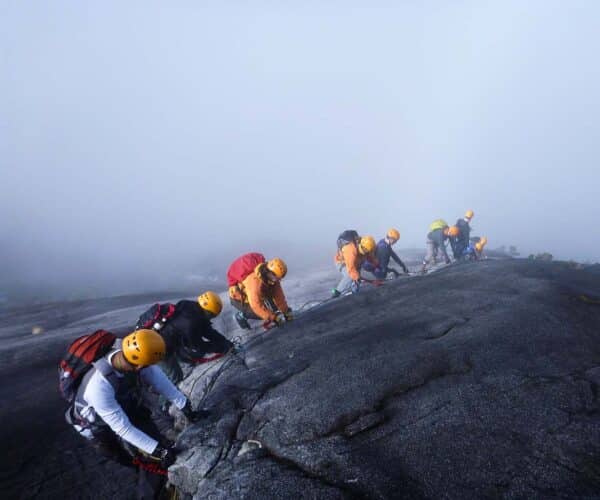When you set off on a climb, you’re also stepping into the unpredictable world of mountain weather. And as every seasoned climber knows, it’s not the summit that determines your success, but the conditions you face getting there.
Recent figures from Mountain Rescue England and Wales show a 24% increase in callouts in 2024 compared to 2019. Many of these rescues weren’t due to freak accidents or elite-level challenges – they happened because climbers were caught out by sudden weather changes or simply weren’t properly prepared.
Social media has played a part too. With more people inspired by reels, posts, and summit selfies, there’s been a surge in visitors to popular peaks. But enthusiasm alone isn’t enough, and too often, that online inspiration doesn’t mention the real risks of wind, rain, fog, or freezing temperatures.
Failing to plan for bad weather isn’t just careless – it can be dangerous. Whether it’s a whiteout on a familiar trail or high winds on an exposed ridge, the consequences can be serious. That’s why preparing for extreme weather is one of the most important things you can do before you lace up your boots.
Here’s how to get it right; from packing smart to route planning and knowing when to turn back. Because good weather might make a day memorable, but it’s your preparation that makes it safe.
Worst weather for climbers

Types of Extreme Weather
Storms and lightning
Thunderstorms can roll in fast, especially in the summer months. Lightning strikes are a real hazard, particularly on exposed ridges or peaks. Timing is crucial — try to summit early in the day and be heading down before storms usually build up.
Heavy snowfall and avalanches
Snow doesn’t just mean cold toes. It can bury trails, hide crevasses, and create dangerous avalanche conditions. Even in spring, snow accumulation on steep slopes can be a killer. Keep tabs on avalanche forecasts and learn how to use a transceiver, probe, and shovel.
High winds
Winds at altitude are more than a nuisance. They can knock you off balance, dramatically lower the temperature (wind chill), and make tent setup a nightmare. Winds also tend to funnel through passes and over summits, so be wary when planning high traverses.
Heavy rain
Climbing in rain might seem less threatening, but in the mountains, it can quickly become a problem. Trails get slick, rivers rise fast, and rock becomes treacherous. Waterproof kit is a must and knowing when to turn around is just as vital.
Poor visibility
Mist, fog, and whiteouts can turn a familiar trail into a maze. Poor visibility often leads to navigational errors and increased risk of injury. Always carry a map and compass and know how to use them without relying solely on GPS.
Seasonal and Regional Considerations
Different locations bring different risks. The Alps in winter present avalanche threats, while monsoon season in the Himalayas means torrential rain and landslides. Shoulder seasons (spring and autumn) can be particularly unpredictable, swinging from sunny to snowstorm in hours. Check local weather patterns and be flexible with your plans.
How terrain and weather interact

Weather doesn’t exist in a vacuum; it interacts with the terrain in complex and sometimes dangerous ways. Rain on sandstone can make the rock dangerously slick and crumbly. Snow covering scree or boulder fields can hide trip hazards or create unstable footing. Ice on granite turns a straightforward scramble into a technical ice climb.
In valleys, rain can lead to flash floods, while in alpine zones, a whiteout might obscure crevasses or cornices. Understanding how the local terrain responds to different weather types helps you make safer decisions. And always expect that trails and conditions will be harder than they look on paper when the weather turns foul.
Route planning with weather in mind
Before setting off, always check the weather, from multiple sources if possible. Mountain forecasts can be wildly different from those at sea level. Learn to read weather charts, cloud formations, and barometric pressure if you want to develop a sixth sense for oncoming storms.
Build flexibility into your plan. Include alternate routes and known escape points. If the summit looks dodgy, have a Plan B hike or a turnaround time. Starting early often gives you the best shot at good conditions, especially in summer when storms build in the afternoon.
During your climb, constantly monitor changes: cloud build-up, sudden gusts of wind, or a drop in temperature can all hint that weather’s on the move.
Gear essentials for extreme weather climbing
Clothing
Think in layers:
- Base layer to wick sweat
- Insulating mid-layer (like fleece or down) for warmth
- Waterproof shell to block wind and rain
Add warm gloves, hat or balaclava, and gaiters in snowy or muddy areas. Always pack an extra pair of dry socks. Wet feet can quickly become a major issue.
Equipment
Depending on conditions, you may need:
- Crampons and ice axe for icy terrain
- Avalanche beacon, probe, and shovel in snowy zones
- Emergency bivvy sack or lightweight shelter
- Weatherproof pack liners or dry bags
- Trekking poles (helpful in slippery or high wind conditions)
Don’t forget navigation tools: a physical map, compass, and GPS (but never rely on the latter alone). A satellite communicator or PLB is a smart move for remote climbs.
Safety and decision-making in bad weather

Know when to turn back
Perhaps the most important skill is knowing when to turn back. The peaks will always be there another day.
Set clear group plans
Talk through emergency plans before setting off. Decide as a group what the cut-off time is and stick to it. Make sure everyone knows the route, key decision points, and what to do if separated. If visibility drops, slow down, stick together, and keep communicating regularly.
Recognise medical risks
Learn how to recognise signs of hypothermia (shivering, confusion, slurred speech) and altitude sickness (headache, nausea, fatigue). Equip your group with basic first aid knowledge and supplies, including thermal blankets, extra food, and water purification.
Have an emergency response plan
Establish clear roles in your group if something goes wrong — who will call for help, who will provide care, and who will stay with the injured party. If someone gets lost or injured, stay calm, use established signals (whistle blasts, reflective gear), and activate your emergency beacon or contact mountain rescue if needed.
Leave a route plan behind
Leave a detailed plan with someone not on the trip, including your expected return time, planned route, backup options, and vehicle location. Check in when you return safely. This simple step can massively speed up rescue efforts if things go wrong.
Practise safety skills in advance
Finally, practise these skills. Rehearse emergency scenarios, navigation in bad weather, and gear checks. Confidence comes from preparation, not luck.
Final tips for climbers
- Always check multiple weather sources
- Watch for early warning signs in the sky
- Don’t be afraid to call it a day
- Practise navigating in poor visibility locally
- Respect the mountain, and never underestimate it
Climbing is as much about decision-making as it is about strength and endurance. With the right preparation, the right gear, and the right mindset, you can face even the worst weather with confidence. Stay flexible, stay alert, and stay safe out there.
Climbing Insurance from SportsCover Direct
5-star rated reviews from thousands of happy customers
Specialist climbing insurance from SportsCover Direct
Extreme adventures are about pushing boundaries and enjoying every moment in the great outdoors. But when bad weather rolls in, preparation is everything. From packing the right kit to planning your route carefully, being ready for the unexpected helps keep you safe — and so does having reliable climbing insurance. It’s one of the best ways to protect yourself and your trip, no matter what the skies throw your way.
SportsCover Direct’s specialist Rock Climbing Insurance offers cover for up to 7,000m. You can select from three policy options, including our sports travel cover which includes going abroad either for leisure or to compete. You’ll benefit from financial cover for medical and repatriation fees, as well as being protected in the event your trip is cancelled or impacted in some way.
There’s also our Travel Insurance Bolt-On, in case you already have a policy for going overseas that doesn’t cover rock climbing. Lastly, the Sports Accident policy gives you peace of mind if an incident occurs, including personal liability and protection for loss of earnings.
Get an instant quote for a rock-climbing policy to suit your needs. If you have any questions, contact our friendly team.
This blog has been created as general information and should not be taken as advice. Make sure you have the correct level of insurance for your requirements and always review policy documentation.